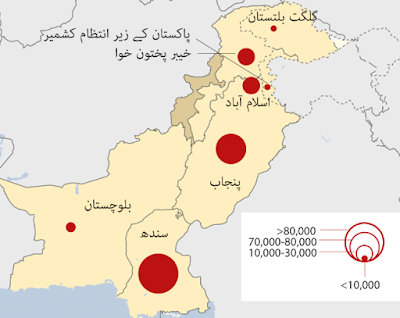Corona virus: Why are there doubts about the data collected for testing for COD 19 disease in Pakistan?
Corona virus: Why are there doubts about the data collected for testing for COD 19 disease in Pakistan?
June 24 was a difficult day for the provincial capital, Lahore, according to daily statistics from Punjab, the province most affected by coronavirus deaths in Pakistan. In those 24 hours, code-19 disease claimed 55 lives in Lahore, a record so far. In the last five days before June 24, 119 people died of the corona virus in Lahore, an estimated 24 deaths per day.
But when the provincial figures for June 25 came out, it was surprising that not a single death had taken place in Lahore. The BBC contacted Mayo Hospital, the largest coronavirus hospital in Lahore, for treatment. According to hospital data, there were three confirmed and five unconfirmed deaths from Code 19 on June 24, two certified and five unconfirmed deaths on June 25, and one confirmed and three unconfirmed deaths on June 26. The reason for collecting the three-day data was to allay fears that deaths after the count deadline had been added to the next day's list. This was not the first time that the number of deaths from the corona virus in Lahore had fluctuated.
According to provincial daily statistics, 64 people were killed in Lahore on May 4, while the number dropped to 60 on May 5. Similarly, there were 72 deaths on May 7, which was reduced to 65 on May 8 and further reduced to 64 on May 9. Similarly, if we look at the statistics of Rawalpindi city, from June 25 to June 27, the city Not a single person was diagnosed with code 19 and the total number was limited to 5,722 for three days. But it was a mystery because Rawalpindi is the second most affected city in Punjab after Lahore and it was a surprise that no patients came from there.
When data was obtained from Rawalpindi city officials for this purpose, it showed that from June 24 to June 28, more than 3,000 tests were conducted in the city, which resulted in the diagnosis of more than 350 affected people. Which were not included in the daily statistics. In addition, when the BBC compared the total deaths in Lahore and Karachi this year and in June last year, there was a clear difference between them, raising questions as to why there were so many deaths compared to the average. And isn't the death toll from the epidemic being hidden?
Similarly, in April, May and June, it was observed several times that according to the official website, the total number of tests conducted in a day, if compared with the tests conducted in the provinces, shows a difference. Global experts believe that it will be very difficult to understand the spread of the disease and develop strategies to prevent its spread without collecting accurate, reliable and quick data to fight the Corona virus epidemic. But many in Pakistan have expressed skepticism after the above examples, and especially in the month of June, saw a clear and sudden decline in the number of both testing and infected people in Pakistan. Testing and the declining number of victims have been questioned by many critics as to whether there is any oversupply of data collected on code 19 in Pakistan. Are the differences between them really correct and are the result of the success of government initiatives, or is it due to mismanagement and other reasons?
What happened in Pakistan in the month of June?
The four-month-old Corona virus epidemic in Pakistan not only spread rapidly in the first three weeks of June, but also killed an average of 100 people a day. But in the last ten days since then, the average daily death toll has dropped to 90, but there has been a more significant decline in the number of tests. It should be noted that 283 deaths were recorded in the last four days of May after Eid-ul-Fitr and this series of deaths continued in early June.
In the first ten days of June, more than 47,000 new cases were identified in Pakistan and 813 people became infected. What is somewhat welcome is that during this period, Pakistan was able to conduct more than 20,000 tests a day. On June 3, Pakistan conducted more than 20,000 tests a day for the first time, and on June 8, for the first time, the country recorded more than 100 deaths in 24 hours. During this period, Pakistan conducted an average of about 22,000 tests a day.
On June 7, the World Health Organization (WHO) warned that Pakistan was among the top 10 countries in the world where the virus was spreading rapidly and that it needed to step up its testing and lockdown strategy. It will have to be tough. In this context, over the next ten days of the month, according to the National Command and Operations Center (NCOC), the central body fighting the Corona epidemic in Pakistan, Pakistan increased its daily testing capacity from 23,000 to 32,000, and Then it reached 50,000 which was also the demand of the World Health Organization. But it is noteworthy that despite the rapid increase in capacity, the number of tests performed daily could not exceed 31,000.
Between June 11 and 20, a total of more than 57,000 victims in Pakistan were exposed to an average of about 5,800 per day, and 1145 deaths occurred in just ten days, compared to an average of 115 per day. During this period, Pakistan set new records for daily deaths (June 19: 153), daily victims (June 13: 6825) and daily testing (June 19: 31681) which remain intact.
Contrary to the recommendations of the Punjab government and the World Health Organization, Prime Minister Imran Khan repeatedly stressed in his speeches in June that the country could not afford a severe lockdown. However, on June 15, the NCOC declared 20 cities in the country as 'hotspots' for the corona virus and immediately issued a 'smart lockdown'. According to a study conducted by the World Health Organization on lockdown in China, the effects of lockdown occur after two to three weeks if the rules for maintaining social distances are strictly followed.
One reason for this is that in people infected with the corona virus, it can take about one to two weeks for symptoms to appear, while the duration of the infection itself can be around two to three weeks. The majority are victims who have no symptoms at all. But in the light of official figures in Pakistan, it appears that the number of victims has dropped dramatically from June 21 to 30, and in these ten days it has dropped by almost 35% compared to the previous ten days. 37,000 new victims were identified.
The death toll also fell 21 percent from the previous ten days, with 894 people killed in the last ten days of the month. One reason for the decline in the identification of new victims may have been the low number of tests.
While Pakistan set a record of daily testing between June 11 and 20 and conducted about 28,000 to 30,000 tests daily, the number of tests conducted in the last ten days of June, despite having the capacity to conduct 71,000 tests daily, decreased by 20%. The daily average dropped to 23,000 tests.
Daily testing capacity in Pakistan and gradual decline in daily testing: what are the facts?
Find, isolate, and test everyone, test everyone you meet with each affected person, and quarantine them.
He further stressed that testing alone or social distance or wearing a mask would not work but that all precautionary measures should be taken at the same time.
"Only countries that have adopted this integrated strategy have succeeded in overcoming migration and deaths."
Other experts say that in order to control the corona virus,
"it must go and hunt on its own, instead of waiting and chasing it."
This raises the question of whether Pakistan is pursuing such a comprehensive strategy, and whether this is why the veracity of the data is being questioned. Responding to these concerns, Dr Faisal Sultan, Prime Minister Imran Khan's focal person for code 19, told the BBC that there were various reasons for the lack of testing in the last days of June. He said that usually the people who have symptoms come for testing and the other way is to monitor and test those who have contact with the affected people.
"In the first case, there is nothing we can do because people have to come by themselves, but contact tracing can make a difference in our ability to identify." However, this depends on the circumstances and for many reasons it is not always possible to do so. It can definitely be improved. Explaining another reason for the decline in the number of tests, Dr. Faisal Sultan said that under the new policy, the government has stopped testing passengers from abroad who do not have symptoms, which has led to a decrease in the number of tests.Explaining the lack of testing, a senior government official who attended the NCOC meeting said that there were various reasons for this and that they were acting cautiously as the public was aware of it.
"Instead of testing the general public in different parts of Pakistan, the health department is now focusing only on specific individuals who pass the test to test for Code 19, meaning they have clear symptoms and are therefore affected. The number of patients and tests has decreased. However, the same official also said that one problem is still that some people hide the disease as a cause of stigma and avoid talking about it and do not go for tests.
Talking about the accuracy of the data, the official said that 19 Focal Persons have been deployed in all the provincial health departments whose job it is to ensure that all the information is being collected correctly. Sometimes ambiguity arises due to information coming in at different times.





Comments
Post a Comment